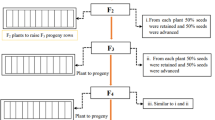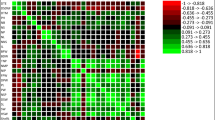Abstract
Variation in seed production and its components was investigated between and within four cultivars of the pasture grass Setaria sphacelata, in two experiments over two years, as a basis for future cultivar improvement. The study sought to determine the basis for the considerable differences in seed production of the four cultivars Nandi, Narok, Solander and Kazungula, to determine the extent of genetic variation in the four cultivars in attributes which contribute to seed yield, and to investigate genotypic consistency in seed production over years and seasons. Each experiment comprised 50 genotypes of each cultivar. In the first experiment, plants were harvested a set number of days after median flowering date whereas in the second experiment, which was unreplicated, each genotype was harvested a set number of days after it had flowered. In the first experiment, seed yields were generally highest for Kazungula, lowest for Narok and intermediate for Nandi and Solander. All measured attributes contributing to seed yield exhibited a high order of variation between and within cultivars, but the basis for the large difference in seed yield per plant between cultivars was tiller fertility rather that total tiller number. Averaged over the four harvests, there was a six fold to > 100–fold intra-cultivar genetic range in seed production, associated with differences in tiller fertility, which were associated with differences in date of first flowering. Broad sense heritability for seed yield averaged 0.68 for the four cultivars and showed little change over the four harvests. Genotypes which produced high seed yields in summer were also more productive of seed in autumn and the 0ore productive genotypes in the first year were also more productive in the second year. Cultivars differed in the relative importance of factors which contributed to the high seed yield of high-yielding genotypes. In the second experiment, genotypes with a high seed yield also generally had the highest tiller fertility, even though all genotypes were harvested the same number of days after first flowering. Within-cultivar correlations in seed yield between the two experiments were generally significant and the elite 20% of genotypes from this experiment had 1.2–2.9 times the seed yield of the same genotypes with a very different harvesting regime in the first experiment. It is concluded that opportunities exist in all four cultivars for improvement in seed production and that the selection criterion offering the best opportunity for advance would be fertile tiller number. In Narok, Solander and Nandi, this would result in increased tiller fertility, whereas in Kazungula, it would result in an increase in total tiller number.
Similar content being viewed by others
References
Bahnisch, L.M. & L.R. Humphreys, 1977. Urea application and time of harvest effects on seed production of Setaria anceps cv. Narol. Aust J Exp Agric Anim Husb 17: 621–628.
Boonman, J.G., 1973. Experimental studies on seed production of tropical grasses in Kenya. 6. The effect of harvest date on seed yield in varieties of Setaria sphacelata, Chloris gayana and Panicum coloratum. Neth J Agric Sci 21: 3–11.
Boonman, J.G. & A.J.P. van Wijk, 1973. Experimental studies on seed production of tropical grasses in Kenya. 7. The breeding for improved seed and herbage productivity. Neth J Agric Sci 21: 12–23.
Bugge, G., 1987. Selection for seed yield in Lolium perenne L. Plant Breed 98: 149–155.
Chadhokar, P.A. & L.R. Humphreys, 1973. Effect of tiller age and time of nitrogen stress on seed production of Paspalum plicatulum. J Agric Sci Cambridge 81: 219–229.
Condé, A. dos R. & J. Garcia, 1984. Maturidade fisiologica das sementes do capim kazungula. Revista Brasiliera de Sementes 6: 87–95.
Elgersma, A., 1990a. Spaced plant traits related to seed yield in plots of perennial ryegrass (Lolium perenne L.). Euphytica 51: 151–161.
Elgersma, A., 1990b. Heritability estimates of spaced-plant traits in three perennial ryegrass (Lolium perenne L.) cultivars. Euphytica 51: 163–171.
Hacker, J.B., 1991. Seed production potential in bred populations and cultivars of Setaria sphacelata. Trop Grasslds 25: 253–261.
Hacker, J.B., 1994. Seed production and its components in bred populations and cultivars of winter-green Setaria sphacelata at two levels of applied nitrogen fertiliser. Aust J Exp Agric 34: 153–160.
Hill, M.J. & B.R. Watkin, 1975. Seed production studies on perennial ryegrass, timothy and prairie grass. 1. Effect of tiller age on tiller survival, ear emergence and seedhead components. J Br Grassld Sci 30: 63–71.
Loch, D.S., 1975. Seed production problems with improved forage varieties of tropical grasses. Aust Seed Sci Newsl 1: 34–38.
Loch, D.S., 1985. Commercial seed increase of new pasture cultivars: organisation and practice. In: J.A. Kategile (Ed.), Pasture Improvement Research in Eastern and Southern Africa, pp. 392–424. Development Research Centre, Ottawa, Canada.
Nada, Y., 1980. Photoperiodic responses in flowering of main tropical pasture grasses. J Jap Grassld Sci 26: 157–164.
Nguyen, H.T. & D.A. Sleper, 1983. Genetic variability of seed yield and reproductive characters in tall fescue. Crop Sci 23: 621–626.
Oram, R.N., 1990. Register of Australian Herbage Plant Cultivars. CSIRO, East Melbourne, Australia.
Zago, C.P., D. do Nascimento Jr, E.M. Alvarenga & M.E. da Cruz, 1984. Produça o de sementes de forrageiras. I. Efeito da época de colheita nos capins andropogon (Andropogon gayanus var. bisquamulatus cv. Planaltina), Setaria (Setaria sphacelata var. sericea cv. Kazungula) e Coloniao (Panicum maximum Jacq.). Revista da Sociedade Brasileira de Zootecnia 13: 463–469.
Author information
Authors and Affiliations
Rights and permissions
About this article
Cite this article
Hacker, J., Cuany, R. Genetic variation in seed production and its components in four cultivars of the pasture grass Setaria sphacelata. Euphytica 93, 271–282 (1997). https://doi.org/10.1023/A:1002932432121
Issue Date:
DOI: https://doi.org/10.1023/A:1002932432121




